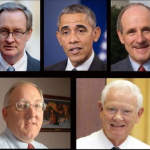Supreme Court’s Immigration Case Sparking Nationwide Protests

Protesters opposed to President Obama’s executive actions on DACA and DAPA rally in front of San Bernardino City Hall. (Herald News photo by Alejandro Cano)
It’s a long way from Washington, D.C., to the Inland Empire section of California near Los Angeles. But immigration activists there are taking to streets, along with other demonstrations across the United States, to encourage the U.S. Supreme Court to side with President Obama over his sweeping immigration reforms.
The Fontana Herald-News backgrounded that “… the Supreme Court on April 18 began hearing oral arguments on President Barack Obama’s executive actions on immigration that would shield more than 4 million undocumented residents from deportation. Five out of eight votes are needed for the Deferred Action on Childhood Arrivals (DACA) and the Deferred Action for Parents of Americans (DAPA) to go forward; however, the Court seemed divided 4-4 along conservative and liberal lines.”
Five out of eight votes are needed for the Deferred Action on Childhood Arrivals (DACA) and the Deferred Action for Parents of Americans (DAPA) to go forward; however, the Court seemed divided 4-4 along conservative and liberal lines. Transcripts from oral arguments indicated that while Justices John Roberts and Samuel Alito worried about the language of Obama’s decrees, Justices Sonia Sotomayor and Ruth Bader Ginsburg noted the humanitarian side of the actions.
The Herald-News says that “… the division could be seen in the streets of the nation, including the Inland Empire, where two opposing groups rallied in Riverside and San Bernardino that day.”
Read the solidly reported story here: http://www.fontanaheraldnews.com/news/supreme-court-hears-oral-arguments-on-immigration-case-protesters-rally/article_e51d93c6-073b-11e6-8f1d-377d69ce8da9.html





